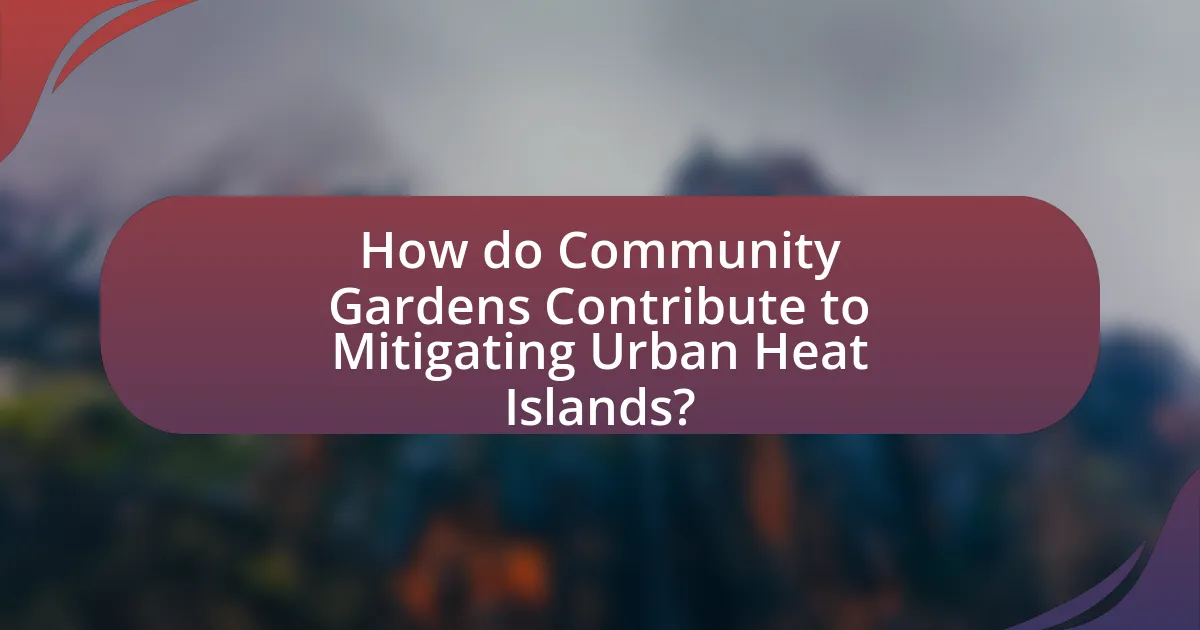Community gardens play a vital role in mitigating Urban Heat Islands (UHIs), which are urban areas that experience significantly higher temperatures than their rural counterparts due to human activities and land modifications. This article explores how community gardens increase vegetation cover, thereby lowering surface and air temperatures through processes like evapotranspiration and shading. It also examines the environmental and health impacts of UHIs, including increased energy consumption and health risks, while highlighting the social and economic benefits of community gardens, such as enhanced community cohesion and improved local food security. Additionally, the article discusses best practices for establishing and maintaining community gardens to ensure their sustainability and effectiveness in combating urban heat.

What are Urban Heat Islands and Why Do They Matter?
Urban Heat Islands (UHIs) are urban areas that experience significantly higher temperatures than their rural surroundings due to human activities and modifications to land surfaces. This phenomenon occurs because cities have more concrete, asphalt, and buildings that absorb and retain heat, leading to temperature increases that can be as much as 5 to 10 degrees Fahrenheit higher than nearby rural areas. UHIs matter because they contribute to increased energy consumption for cooling, elevated emissions of air pollutants and greenhouse gases, and heightened health risks, particularly for vulnerable populations. Studies indicate that urban heat islands can exacerbate heat-related illnesses and mortality, especially during heatwaves, making their mitigation crucial for public health and environmental sustainability.
How do Urban Heat Islands form in urban areas?
Urban Heat Islands form in urban areas primarily due to the concentration of buildings, roads, and other infrastructure that absorb and retain heat. These surfaces, often made of materials like asphalt and concrete, have a lower albedo compared to natural landscapes, leading to increased heat absorption during the day and slower heat release at night. Additionally, human activities such as transportation and industrial processes contribute to elevated temperatures through emissions and heat generation. Studies indicate that urban areas can be 2 to 5 degrees Fahrenheit warmer than their rural surroundings, highlighting the significant impact of urbanization on local climate.
What factors contribute to the development of Urban Heat Islands?
Urban Heat Islands develop primarily due to the concentration of human activities and infrastructure in urban areas. Factors contributing to this phenomenon include the extensive use of concrete and asphalt, which absorb and retain heat, reducing natural vegetation that would otherwise provide cooling through shade and evapotranspiration. Additionally, the heat generated from vehicles, buildings, and industrial processes exacerbates temperature increases. Research indicates that urban areas can be 2 to 5 degrees Fahrenheit warmer than surrounding rural areas, primarily due to these factors.
How do Urban Heat Islands impact local climates?
Urban Heat Islands (UHIs) significantly raise local temperatures compared to surrounding rural areas due to human activities and land use changes. This phenomenon occurs because urban surfaces, such as asphalt and concrete, absorb and retain heat more effectively than natural landscapes, leading to temperature increases that can be as much as 5 to 10 degrees Fahrenheit. Research indicates that UHIs can exacerbate energy consumption, increase air pollution, and elevate heat-related health risks, particularly during summer months. For instance, a study by the U.S. Environmental Protection Agency found that urban areas can experience temperatures 1 to 7 degrees Fahrenheit higher than nearby rural areas, impacting local weather patterns and increasing the demand for air conditioning, which in turn raises greenhouse gas emissions.
What are the environmental and health effects of Urban Heat Islands?
Urban Heat Islands (UHIs) lead to increased temperatures in urban areas compared to their rural surroundings, resulting in significant environmental and health effects. Environmentally, UHIs contribute to elevated energy consumption for cooling, increased air pollution, and altered precipitation patterns, which can exacerbate flooding and water quality issues. Health-wise, UHIs are linked to higher rates of heat-related illnesses, respiratory problems due to poor air quality, and increased mortality rates during heatwaves, particularly affecting vulnerable populations such as the elderly and those with pre-existing health conditions. Studies indicate that urban areas can be up to 5-7 degrees Fahrenheit warmer than surrounding areas, intensifying these effects.
How do Urban Heat Islands affect air quality?
Urban Heat Islands (UHIs) negatively impact air quality by increasing temperatures in urban areas, which exacerbates the formation of ground-level ozone and other pollutants. Higher temperatures accelerate chemical reactions that produce ozone, leading to elevated levels of this harmful pollutant, which can cause respiratory issues and other health problems. Studies indicate that urban areas can be 2 to 5 degrees Fahrenheit warmer than surrounding rural areas, contributing to increased smog formation and deteriorating air quality.
What health risks are associated with increased temperatures in Urban Heat Islands?
Increased temperatures in Urban Heat Islands (UHIs) are associated with several health risks, including heat-related illnesses, respiratory issues, and exacerbation of chronic conditions. The elevated temperatures can lead to heat exhaustion and heat stroke, particularly affecting vulnerable populations such as the elderly and those with pre-existing health conditions. Additionally, higher temperatures can worsen air quality by increasing ground-level ozone, which can trigger asthma and other respiratory problems. Studies indicate that urban areas can experience temperature increases of 2 to 5 degrees Fahrenheit compared to surrounding rural areas, intensifying these health risks.

How do Community Gardens Contribute to Mitigating Urban Heat Islands?
Community gardens contribute to mitigating urban heat islands by increasing vegetation cover, which lowers surface and air temperatures. The presence of plants in these gardens provides shade and facilitates evapotranspiration, processes that cool the surrounding environment. Research indicates that urban areas with more green spaces, such as community gardens, can experience temperature reductions of up to 5 degrees Fahrenheit compared to areas with minimal vegetation. This cooling effect is crucial in densely populated cities where heat islands can exacerbate health risks and energy consumption.
What role do plants play in cooling urban environments?
Plants play a crucial role in cooling urban environments through processes such as evapotranspiration and shading. Evapotranspiration occurs when plants release water vapor into the air, which cools the surrounding atmosphere; studies show that urban areas with vegetation can be up to 5 degrees Fahrenheit cooler than those without. Additionally, trees and plants provide shade, reducing surface temperatures on buildings and pavements, which can significantly lower energy consumption for cooling. Research indicates that increasing urban greenery can mitigate the urban heat island effect, leading to improved air quality and enhanced urban resilience.
How does vegetation reduce surface and air temperatures?
Vegetation reduces surface and air temperatures primarily through the processes of evapotranspiration and shading. Evapotranspiration occurs when plants release water vapor into the atmosphere, which cools the surrounding air as it evaporates. This process can lower air temperatures by several degrees, significantly impacting local microclimates. Additionally, vegetation provides shade, which directly reduces surface temperatures by blocking sunlight from reaching the ground. Studies have shown that urban areas with increased vegetation can experience temperature reductions of up to 5 degrees Celsius compared to areas with minimal greenery, demonstrating the effectiveness of plants in mitigating heat.
What specific plants are most effective in community gardens for cooling?
Specific plants that are most effective in community gardens for cooling include trees such as the American sycamore, red maple, and oak, as well as shrubs like boxwood and holly. These plants provide shade and release moisture through transpiration, which helps lower surrounding temperatures. Research indicates that urban areas with increased tree canopy cover can experience temperature reductions of up to 10 degrees Fahrenheit compared to areas with minimal vegetation. Additionally, studies show that the presence of diverse plant species in community gardens enhances cooling effects, contributing to the mitigation of urban heat islands.
How do community gardens enhance urban biodiversity?
Community gardens enhance urban biodiversity by providing habitats for various plant and animal species, thereby increasing the overall ecological diversity in urban areas. These gardens create green spaces that support pollinators, such as bees and butterflies, and foster a variety of flora that can thrive in urban settings. Research indicates that urban gardens can host up to 50% more species than surrounding areas, contributing to greater ecological resilience and improved ecosystem services. Additionally, community gardens often incorporate native plants, which are crucial for local wildlife and help maintain the balance of urban ecosystems.
What is the relationship between biodiversity and temperature regulation?
Biodiversity plays a crucial role in temperature regulation by enhancing ecosystem resilience and functionality. Diverse plant species in ecosystems, such as community gardens, contribute to cooling effects through processes like evapotranspiration, where water is absorbed by plants and released as vapor, thereby lowering surrounding temperatures. Research indicates that areas with higher biodiversity can experience reduced urban heat island effects, as diverse vegetation provides shade and mitigates heat absorption by surfaces. For instance, a study published in “Environmental Research Letters” by K. J. G. McDonald et al. (2020) found that urban areas with greater plant diversity had significantly lower surface temperatures compared to those with less diversity, demonstrating the direct impact of biodiversity on temperature regulation.
How do community gardens support local wildlife?
Community gardens support local wildlife by providing essential habitats and food sources for various species. These gardens create diverse ecosystems that attract pollinators like bees and butterflies, as well as birds and small mammals. Research indicates that urban green spaces, including community gardens, enhance biodiversity by offering native plants that serve as food and shelter. For instance, a study published in the journal “Urban Ecology” found that community gardens can increase the abundance of pollinators by up to 50% compared to surrounding urban areas. This increase in biodiversity contributes to healthier ecosystems and supports the overall balance of local wildlife populations.

What are the social and economic benefits of Community Gardens in Urban Areas?
Community gardens in urban areas provide significant social and economic benefits, including enhanced community cohesion and increased access to fresh produce. These gardens foster social interactions among diverse community members, promoting a sense of belonging and collaboration, which can lead to reduced crime rates and improved mental health. Economically, community gardens can lower food costs for participants and contribute to local economies by creating jobs related to gardening, maintenance, and local markets. A study by the American Community Gardening Association found that community gardens can increase property values in surrounding areas by up to 10%, demonstrating their positive impact on local economies.
How do community gardens foster community engagement?
Community gardens foster community engagement by providing a shared space for individuals to collaborate on gardening projects, thereby enhancing social interactions and building relationships among diverse community members. These gardens serve as platforms for education, where participants can learn about sustainable practices and healthy eating, which further encourages participation and investment in the community. Research indicates that community gardens can increase social cohesion, as evidenced by a study published in the Journal of Community Psychology, which found that neighborhoods with community gardens reported higher levels of trust and cooperation among residents.
What activities promote social interaction in community gardens?
Activities that promote social interaction in community gardens include group planting events, workshops, potlucks, and volunteer days. Group planting events encourage collaboration among participants, fostering relationships as they work together to cultivate the garden. Workshops provide educational opportunities where community members can share knowledge and skills, enhancing social bonds. Potlucks create a communal atmosphere, allowing individuals to share food and stories, further strengthening connections. Volunteer days invite community members to contribute their time and effort, promoting teamwork and a sense of belonging. These activities have been shown to enhance community cohesion and improve social networks, as evidenced by studies highlighting the role of community gardens in building social capital.
How do community gardens contribute to local food security?
Community gardens enhance local food security by providing accessible, fresh produce to urban populations. These gardens enable communities to grow their own fruits and vegetables, reducing reliance on external food sources and increasing self-sufficiency. According to a study published in the Journal of Agriculture, Food Systems, and Community Development, community gardens can significantly improve food access in low-income neighborhoods, where traditional grocery stores may be scarce. By fostering local food production, community gardens also promote sustainable practices and strengthen community ties, further contributing to food security.
What economic advantages do community gardens provide?
Community gardens provide significant economic advantages by reducing food costs and increasing property values. By allowing local residents to grow their own produce, community gardens lower the expenses associated with purchasing food, particularly in urban areas where fresh produce may be expensive or inaccessible. Additionally, studies have shown that properties located near community gardens often experience an increase in value, as these green spaces enhance neighborhood aesthetics and promote community engagement. For instance, a study published in the Journal of Urban Affairs found that proximity to community gardens can increase property values by up to 10%. This dual impact of cost savings on food and increased property values illustrates the economic benefits that community gardens offer to urban communities.
How can community gardens increase property values in urban neighborhoods?
Community gardens can increase property values in urban neighborhoods by enhancing the aesthetic appeal and providing green space, which attracts potential buyers. Studies indicate that properties located near well-maintained green spaces, such as community gardens, can see an increase in value by as much as 20%. Additionally, community gardens contribute to improved air quality and reduced urban heat, making neighborhoods more desirable. Research from the American Society of Landscape Architects shows that proximity to green spaces positively influences property prices, as buyers often prioritize access to parks and gardens when selecting homes.
What role do community gardens play in local economies?
Community gardens significantly contribute to local economies by enhancing food security, creating jobs, and fostering local entrepreneurship. These gardens provide fresh produce, which can reduce food costs for residents and increase access to healthy food options, particularly in food deserts. According to a study by the American Community Gardening Association, community gardens can generate approximately $1,000 to $5,000 in produce value per year, directly benefiting local households. Additionally, they create employment opportunities through garden management, maintenance, and related activities, thus stimulating local job markets. Furthermore, community gardens often serve as platforms for local businesses, such as farmers’ markets and workshops, promoting economic activity within the community.
What are some best practices for establishing and maintaining community gardens?
Best practices for establishing and maintaining community gardens include engaging the community in the planning process, selecting appropriate locations, and ensuring sustainable practices. Engaging the community fosters ownership and commitment, which is crucial for long-term success. Selecting locations with adequate sunlight, water access, and soil quality enhances plant growth and garden productivity. Implementing sustainable practices, such as organic gardening techniques and water conservation methods, not only supports environmental health but also contributes to the mitigation of urban heat islands by increasing vegetation cover and reducing surface temperatures. Research indicates that urban green spaces can lower surrounding temperatures by up to 5 degrees Fahrenheit, demonstrating the effectiveness of community gardens in combating heat.
How can communities effectively plan and design a community garden?
Communities can effectively plan and design a community garden by engaging local residents in the decision-making process, assessing site conditions, and establishing clear goals for the garden. Engaging residents ensures that the garden meets the needs and preferences of the community, while site assessment involves evaluating factors such as sunlight, soil quality, and water access, which are critical for plant growth. Establishing clear goals, such as promoting biodiversity or providing fresh produce, guides the design and layout of the garden. Research indicates that community gardens can reduce urban heat islands by providing shade and increasing vegetation cover, which lowers surface temperatures. For example, a study by the American Society of Landscape Architects found that urban green spaces can reduce temperatures by up to 5 degrees Fahrenheit, demonstrating the environmental benefits of well-planned community gardens.
What strategies can be employed to ensure the sustainability of community gardens?
To ensure the sustainability of community gardens, implementing strategies such as establishing strong community involvement, creating a diverse planting scheme, and securing ongoing funding is essential. Strong community involvement fosters a sense of ownership and responsibility among participants, which can lead to increased maintenance and care for the garden. A diverse planting scheme enhances biodiversity, improves soil health, and attracts beneficial insects, contributing to the garden’s resilience. Securing ongoing funding through grants, local sponsorships, or fundraising events ensures that resources are available for maintenance, expansion, and educational programs. These strategies collectively support the long-term viability of community gardens, which play a crucial role in mitigating urban heat islands by providing green spaces that lower temperatures and improve air quality.





